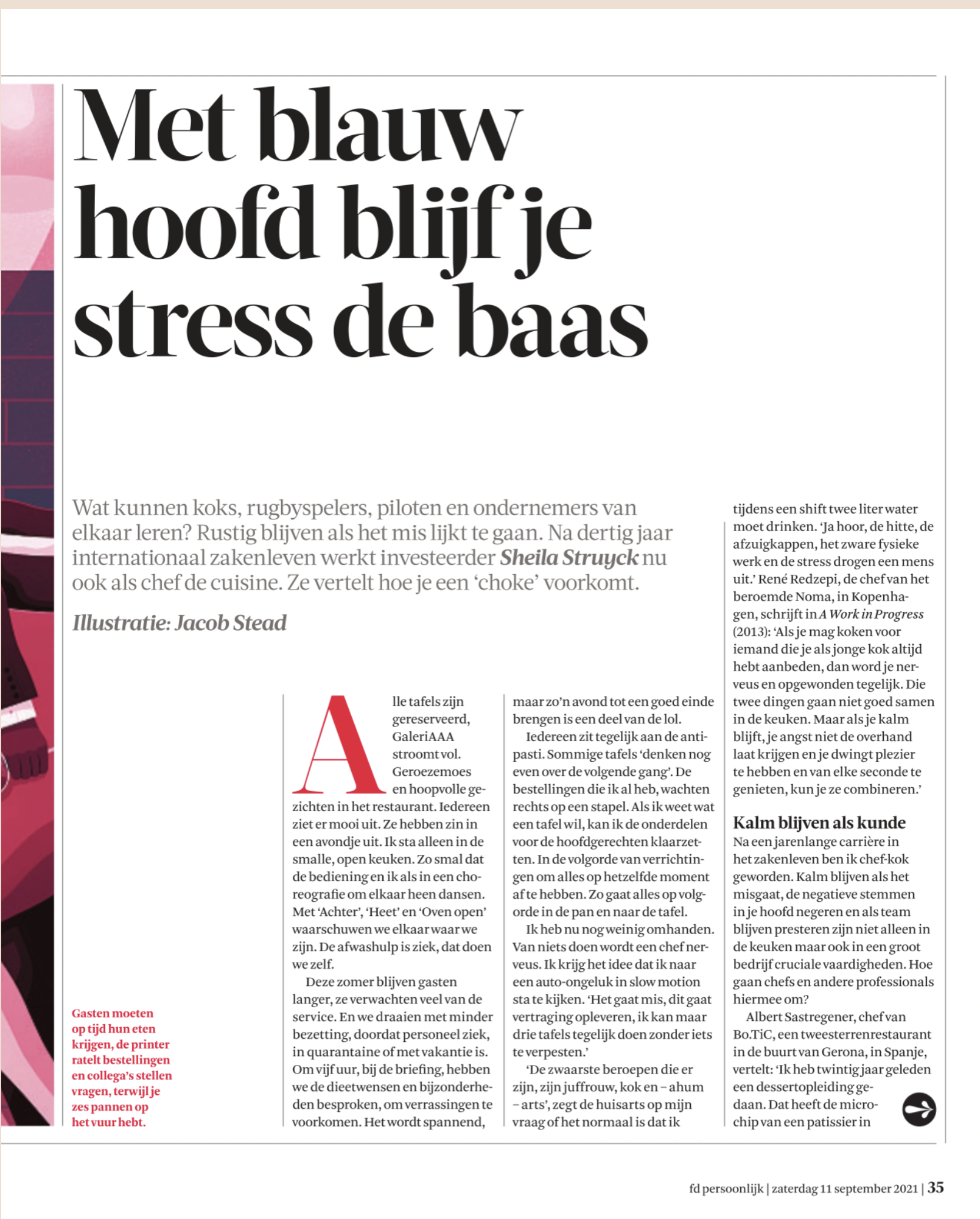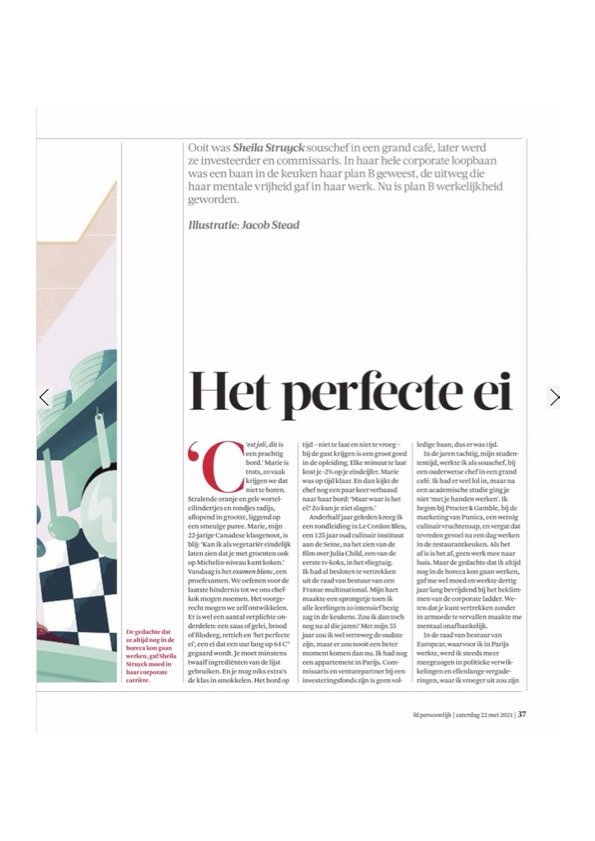The art of waiting
Fast action is the creed in the business world. For a long time, investor Sheila Struyck indeed thought that speed was a quality. But since she also works as a chef, she knows how important waiting is. A good chef can put the time to his or her will. And a good boss in business should consider doing that too.
- Het Financieele Dagblad - 8 January 2022
In my bowl, rests one soft shiny onion with a crispy skin on a large drop of cream. At the table, a steaming, dark brown, clear broth is poured around it. The taste is clean, deep and round. Even the mouthfeel of cheese strings is in it; I don't taste fat and sugar. I am eating at restaurant L'Aliança 1919, in Anglès, Spain. For me, it is an ode to the classic onion soup with bread and melted cheese, but in an elegantly lighter version. Even now, two months later, I can still fully recall the taste, feeling and memory. What is the secret of this soup? The onions are caramelised over a low heat for three days without addition.
In a restaurant you, as a chef, are constantly adjusting the time to your will. Before you put on your uniform, you turn on the oven. Bread is needed for lunch, but it's still in the freezer now, so that should be brought in right away. Then you get started with the pumpkin, parsnips and carrots. Washing, peeling, cutting and immediately after the bread is in the oven there's nothing to worry about. Bring a large pot of water to the boil. Meanwhile, clean the scampi. Cook green beans for three minutes while grilling the large shrimps. And so on, you are always combining activities. Chefs like to cook with techniques that allow you to do something else at the same time without the risk of burning or failing. Tomato sauce that simmers for three hours, dough that rises slowly, celeriac in a salt layer that cooks in the oven for two hours. An experienced chef is always in a hurry, but he or she is also a master at waiting for a nice taste.
The magnificent onion soup from l'Aliançia. Before and after pouring the 'three-day' onion broth
Silicon Valley creeds
At Procter & Gamble, the multinational company where I went to work after college, we knew exactly how many months it took everyone to become a brand manager. The fewer months that it took, the better it was, or so we thought. So, I was always in a hurry and pushed people to deliver faster. I devoured books like The 7 Habits of Highly Effective People and Getting Things Done. Books that are full of tricks to be stingy with your time. With clever shortcuts, how to be in a hurry without showing it. I soon knew: achieving results quickly and ticking off to-do lists gives a satisfied feeling. The thought of 'having soemthing done' produces dopamine in anyones brain.
I wonder whether people really enjoyed working with me. Due to the rush, I often made mistakes, reacted with agitation to questions that in my opinion only cost me time.
With the rise of digital giants, such as Google and Facebook, speed has become almost sacred. 'If you don't fail, you aren't going fast enough' was one of those creeds that was introduced by Silicon Valley, just like: 'move fast and break things'. By rolling out new software as quickly as possible, actually before it is completely finished and bug-free, you will soon find out where the errors are. The users will report them themselves when something goes wrong. Well, if they can find a phone number or other contact details somewhere on the site. That is called agile. Great.
A few years ago, as Director of new mobility and innovation at Europcar, I also always urged the teams to keep moving. I said things like, "How can we speed this up?" and "What seven-mile boots can we put on?" I pushed through decisions and was then surprised that people continued to resist or did not want to go along with the vision. Or that the customers were irritated by the bad customer journey. I then had to put in a lot of time and effort to smooth it all out.
I cooked the same way for years. I made risotto with all kinds of shortcuts. Rice in oil on a high heat, lots of cold water with a stock cube and a stir every ten minutes to prevent burning. Stir in two ounces of cheese at the end for smoothness. 'A real clever risotto', I said proudly, because it seemed reasonable without my wasting time.
The role of umami
Femke van den Heuvel, patiently at work.
Professional chefs see it differently. "Taking time is an important technique," says Femke van den Heuvel. She works for Vip Health & Nutrition, the most important training course for vegetarian cooking chefs. "It's a bit technical, but fried meat has a few functions in a dish. Because of the bite there is something to chew on and you also make saliva, so you can taste more. You also taste umami and that gives the taste depth."
Umami is one of the five basic tastes, with salty, sweet, sour and bitter. It is a Japanese word and means the essence of glory. Our word 'savoury' comes close. Sun-dried tomato, coffee, Parmesan cheese, fried mushrooms, stewed onions, anchovies, soy sauce and seaweed have an umami taste. The taste experience comes from the amino acid glutamic acid, which is released during the preparation of fish and meat, but also during the ripening of fruit, tomatoes and cheese or during fermentation, which actually means controlled rotting.
Ripening and fermentation are pre-eminently techniques that take time. Fermenting is a simple operation, just like marinating or putting something in vinegar. You sometimes have to wait weeks or months, but it's just a matter of doing something else in the meantime. And then, suddenly, the preparation is done. Without heating or fire, that is cooking, too.
With these slow preparations, you create complexity and depth in the taste, without artificial additives. Van den Heuvel gives making soy sauce as an example. "I learned from a TV programme, Keuringsdienst van Waarde, that you only need two ingredients for this and that you have to wait a while. But many cooks are in a hurry and have to do everything they can to give it more flavour."
Edwin Klaasen in his brand new bakery. Broodheeren.
Bad execution
For a few years now, I have been combining my activities as a chef with my activities as a Supervisory Director and investor. And there too I want to wait more. Especially to slow down at the start to save time in execution. For this, I use the fair process leadership of Professor Ludo Van der Heyden . His theory is that poorly executed plans or decisions cause a party to feel unfairly treated or heard. His leadership style is based on the idea that you should take the time to meet and speak to everyone involved in a decision. To know all points of view. If people feel seen and heard, it increases the chance of good performance and therefore a good result.
By showing us real-life cases, Van der Heyden made us aware that, when you are under pressure, you tend to make quick decisions based on limited knowledge. When I took his lectures on Insead, we had to role-play whether we would let a Formula 1 car drive despite defects. We didn't think we had time to ask the drivers what their assessment of the danger was. Lives were even put on the line.
This knowledge came in handy during a leadership crisis in a company in which we are a shareholder through NBI Investors . Despite the pressure and the high risks, the Supervisory Board decided not to intuitively make a quick decision, but to speak to all players in private in order to form a complete picture. A lot of work, that's right, so we just wiped the agenda clean. Not only did the Supervisory Board members receive all kinds of hidden details and information, but everyone also felt heard. Instead of meeting resistance and arguing with them, the employees became part of the solution and all kinds of processes started to run on their own. This outcome was surprising, I didn't have to put any pressure on them at all.
Not only do chefs like to put time to work, bakers do too. Edwin Klaasen is the owner of Broodheeren, an artisan bakery for top restaurants. "Time is everything for us," he says. "Even with the best ingredients, it won't work if you don't give them time. My methods and recipes cannot take effect without time. Because every dough is different – it is a natural product – you have to keep feeling and wait for the bacteria to do its job." Klaasen says he never watches the clock. While the dough is rising, he does other things and tries new things.
Gentle stirring
When I speak to him, I realise that there are similarities between business and the baking process. When making business decisions, you also need to take the time to bring together high-quality, natural ingredients. Then it is a matter of stirring gently and waiting for a nice taste. No artificial interventions.
In business, I have also learned to take the time for a nice outcome that I don't have to tinker with anymore. As a chef, I take my time by doing something that takes a long time, but produces great taste with little effort. So now, I make the risotto very differently than in the past. First heat up the broth. In another pan over a low heat, fry a shallot without browning. Add bomba rice, make it transparent, deglaze with wine. Add the hot stock spoon by spoon. Regular stirring makes it silky and creamy thanks to the starch of the rice grain. Burning does not happen on a low heat. Let it sit for five minutes with lid on. If you want you can grate some Comté over it for the umami, but it's not necessary for the creamy one.
Appeared as an essay in het Financieele Dagbladon 8 January 2022
Earlier essays in the series








